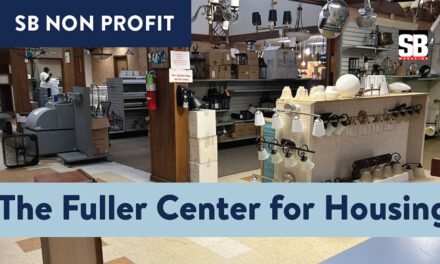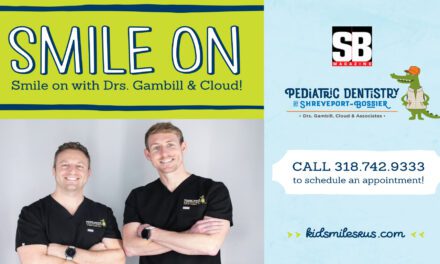FULL STREAM AHEAD!
By Seva May
One of the topics we are focusing on in this issue of SB is the selection we are fortunate to have in private school education. There are over a dozen schools, not counting preschools, in Shreveport-Bossier. I looked at their websites and found that most have a common denominator. STREAM. Most of you will know what this acronym stands for. I was only vaguely familiar with STREAM because I’m old, and my children are grown. If the acronym was being used when they were in school, I wasn’t aware of it. This is for grandparents and parents who might like to know more about this curriculum being taught to our children today.
I learned from Julie Andrews that the best place to start is at the very beginning. A warning before you begin reading: you are going to be inundated with acronyms throughout this abbreviated history. Let’s begin with the early STEM years, which trace back to the Morrill Act of 1862. STEM combines the science, technology, engineering, and mathematics curriculum. The Morrill Act created land grant universities to support agricultural science. Over the course of time, STEM training expanded to the workforce.
By the 1950s, we witnessed great technological advances as we entered the Cold War, the space race with Russia, and President Eisenhower’s inauguration of NASA (National Aeronautics and Space Administration). This marked a heightened interest in science education. As we entered the 21st century, it was glaringly clear that U.S. students’ achievements were lagging behind other industrialized countries. In 2001, the National Science Foundation (NSF) decided to address the situation by creating the first form of the acronym for science, math, engineering, and technology, SMET, which was wisely reordered to spell STEM.
This was a good beginning as state after state began acquiring public and private grants that supported STEM education. That same year, the NCLB Act (No Child Left Behind – don’t you love all these acronyms?) passed. With this act, state-level standardized testing was implemented to ensure high academic standards. Still, our kids were falling behind other countries. In 2009, Obama established the Educate to Innovate Initiative (no acronym) with the goal of moving to the top of the pack in science and math achievement. Federal funding was approved for STEM education and for the training of STEM teachers. The STEM Education Act of 2015 added computer science to the curriculum, which resulted in more teacher training. Congress also passed ESSA (Every Student Succeeds Act), replacing NCLB. It also modified the use of standardized tests while expanding the federal government’s role in public education.
By the 1950s, we witnessed great technological advances as we entered the Cold War, the space race with Russia, and President Eisenhower’s inauguration of NASA (National Aeronautics and Space Administration). This marked a heightened interest in science education. As we entered the 21st century, it was glaringly clear that U.S. students’ achievements were lagging behind other industrialized countries. In 2001, the National Science Foundation (NSF) decided to address the situation by creating the first form of the acronym for science, math, engineering, and technology, SMET, which was wisely reordered to spell STEM.
This was a good beginning as state after state began acquiring public and private grants that supported STEM education. That same year, the NCLB Act (No Child Left Behind – don’t you love all these acronyms?) passed. With this act, state-level standardized testing was implemented to ensure high academic standards. Still, our kids were falling behind other countries. In 2009, Obama established the Educate to Innovate Initiative (no acronym) with the goal of moving to the top of the pack in science and math achievement. Federal funding was approved for STEM education and for the training of STEM teachers. The STEM Education Act of 2015 added computer science to the curriculum, which resulted in more teacher training. Congress also passed ESSA (Every Student Succeeds Act), replacing NCLB. It also modified the use of standardized tests while expanding the federal government’s role in public education.
High-performing nations have well-developed curricula concentrating on 21st-century skills, including inquiry processes, problem-solving, critical thinking, creativity, and innovation. The National Education Association breaks these skills into four primary areas necessary for success in the 21st century: critical thinking and problem-solving, communication, collaboration, creativity, and innovation. Therefore, there is a need to focus on core content knowledge and interdisciplinary processes to advance STEM education.
STREAM is a variant of STEM, which includes the Arts and Reading. It stands for Science, Technology, Reading and wRiting, Engineering, Arts, and Mathematics [3]. It is worth noting that there is some overlap between STEAM and STREAM. However, there is no consensus on what the exact acronym should be, as different schools and institutions adopt different variations depending on their specific educational goals and priorities. For example, many faith-based schools have used the “R” to represent religion and integrate religious themes into the curriculum. Regardless of which acronym is used, the goal remains the same – to provide a well-rounded education that prepares students for various careers in an increasingly complex and technology-driven world.
So, now you have the evolution of this teaching method. The question remains: is it being utilized in our public and private school systems? Have the teachers who are employing “relevant integration of STEM concepts” been fully trained to do so?
To the older generation of educators, STEAM is often poorly defined, with varying levels of implementation. It can be difficult to implement, with teachers reporting challenges with, among other things, collaboration across disciplines, increased workload, and understanding STEAM integration. In 2016, Caddo Parish Public Schools partnered with Discovery Education, the leading provider of digital content and professional development for K-12 classrooms, to launch Caddo Parish Schools and Discovery Education launched Re-Imagine Caddo: The Plan for Excellence. The goal of the iLearn initiative was to build a strong culture of Science, Technology, Engineering, and Math (STEM) districtwide.
Several of our Private Schools offer STREAM, most beginning in pre-kindergarten. St. John Berchmans Catholic School has a curriculum “rooted in STREAM that exposes students to many skills that are highly valuable.” St. Joseph Catholic School integrates technology into each classroom by utilizing state-of-the-art interactive whiteboards and a 1:1 iPad plan. Integrated STREAM and Technology classes have fully equipped labs, which allow students to experience education with 3D virtual tours, robotics, digital citizenship, online safety, and keyboarding. Students at Southfield School begin visiting the STEAM science lab as early as kindergarten.
Beginning in the 2016-2017 school year, schools integrated Discovery Education’s Science Techbook (Grades K-12), Social Studies Techbook (Grades 6-8) and Math Techbook (Grades 6-12) into classroom instruction. In addition, 44 Caddo educators helped develop the district’s culture of STEM education by participating in Discovery Education’s STEM Leader Corps, a six-year professional learning program that develops and nurtures teachers and administrators as they build a culture of STEM teaching and learning in their school system.
Discovery Education’s STEM Leader Corps offered Caddo Parish educators professional development opportunities, job-embedded instructional coaching, and administrative leadership support. Through their engagement in the program, educators developed high-quality STEM lessons, transdisciplinary units, and leadership skills to grow a culture of STEM teaching and learning in their school system. Discovery Education experts worked closely with these teacher-leaders to establish ‘learning lab’ classrooms in their schools. These classrooms provided opportunities for colleagues to observe and collaborate on the instructional strategies demonstrated and modeled in the “learning lab” so they could apply similar teaching strategies in their own classrooms and share with their peers district wide.
“Here at Centenary, our elementary and secondary education majors are learning how to infuse content areas across the STEAM subject areas. There are numerous opportunities for teachers to make connections across curriculum content,” says Terrie Johnson, Education Department Chair and Assistant Professor. “A curriculum labeled STREAM is a very project-based, problem-solving curriculum that involves reading, writing, listening, and speaking.” She goes on to say that every school offers the same thing. It’s just more individualized. You can teach the same content every year, but you don’t teach it the same way every year. Students change, they learn differently, and the culture of the class changes from one year to the next. “Teachers become experts at creating that culture of learning that allows students to flourish. There are overarching standards that guide our work at every grade level in every content area.”
Ironically (or perhaps it was Kismet), while I was visiting Terrie Johnson, I was given a flyer for the inaugural FULL STEAM AHEAD Educator Symposium.
(yes, the event title was too good not to borrow for this story) This exciting new event will be hosted by Centenary College of Louisiana’s Department of Education and Center for Teaching and Learning. The symposium will provide professional development and networking opportunities. By bringing together educators from across disciplines and grade levels, Centenary’s objective is to showcase innovative teaching strategies and cutting-edge research that inspires new inquiry and ideas.
FULL STEAM AHEAD will be held Friday, February 9, 2024, with a Thursday evening reception on February 8, 2024, at Meadows Museum of Art on the Centenary College Campus.
The symposium will include:
- Workshops (75 minutes) provide an interactive and immersive learning experience. Attendees actively participate and engage in hands-on activities, guided by facilitators. Joint proposals welcome.
- Make-and-Take (75 minutes) sessions offer participants the opportunity to engage in creative learning activities. Attendees not only experience these activities but also leave with all the necessary materials and information to replicate them in their own classrooms or work environments.
- Individual presentations (20 minutes) provide a platform for researchers, experts, or thought leaders to share their knowledge, insights, and findings with a wider audience. Individual presentations may be grouped by topic on the conference schedule.
- Panel discussions (75 minutes) assemble multiple presenters to engage in a dynamic conversation centered around a specific topic or theme.
- Poster presentations are visual displays of research, projects, or ideas. Presenters submit a description of their work in advance and bring a poster to the conference for display.
Everyone is welcome to attend, especially K-12 and college/university educators who teach or are interested in STEAM, future teachers, teacher educators, administrators who support teachers, community leaders who support teachers, and professional development providers.
As the Center for Innovation and Education explains, “STEAM engages students in learning. Many students have greater aptitude and affinity for either arts and humanities or mathematics and science. STEAM education, with its integrated and holistic approach, helps students conceptualize these disciplines as parts of a greater whole. Rather than feeling alienated or tuned out of certain subjects, they can collaborate with others to solve problems and see subjects they struggle with in a different way.
STEAM also taps into children’s natural curiosity and creativity. If you’ve ever tried to find answers to a long series of questions asked by a child, you know how inquisitive they are about the world around them! STEAM lessons focus on deep questioning and finding novel solutions rather than memorizing standard facts and figures that can easily be “Googled.” *
Here’s an acronym I made up that puts a button on this piece – STEP. Start Them Early Parents.
Every parent should take a deep interest in their child’s education from an early age. Our educators are doing their part. It’s time we STEPped up. (spell check is having a fit with this one.)
*Center for Innovation and Education, a division of Space Foundation, is a lifelong learning platform for the global space ecosystem that delivers workforce development and economic opportunity for students, teachers, entrepreneurs, and professionals via programs offered digitally worldwide or at Discovery Center in Colorado Springs, Colorado.









